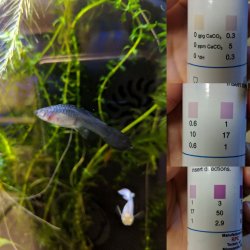iheartjeffrey
Fish Fanatic
- Joined
- May 9, 2011
- Messages
- 60
- Reaction score
- 0
So my guppies have been dying one by one. But it's like two weeks between deaths. I've had this setup for about a year so no idea what's gone wrong.
Their fins become clamped and they just sort of shimmy. I also noticed that the they start to seem rather thin at the belly once they start to get worse. And not to mention my shrimp are dying one by one? I have rummy nose tetras as well and they seem totally fine, none of them have died or been affected.
I checked water parameters and they are : pH is 7.6. Ammonia is 0, Nitrites 0, Nitrates 0??
I'm so confused! It's heavily planted and always has been. Anacharis, water Spangles, dwarf water lettuce, ludwigia. 3 tetras, There were 4 guppies, now only two. And shrimp. It's a 5 gallon tank which I know is considered heavily stocked but this is the first time these deaths have happened in this tank?
Their fins become clamped and they just sort of shimmy. I also noticed that the they start to seem rather thin at the belly once they start to get worse. And not to mention my shrimp are dying one by one? I have rummy nose tetras as well and they seem totally fine, none of them have died or been affected.
I checked water parameters and they are : pH is 7.6. Ammonia is 0, Nitrites 0, Nitrates 0??
I'm so confused! It's heavily planted and always has been. Anacharis, water Spangles, dwarf water lettuce, ludwigia. 3 tetras, There were 4 guppies, now only two. And shrimp. It's a 5 gallon tank which I know is considered heavily stocked but this is the first time these deaths have happened in this tank?


